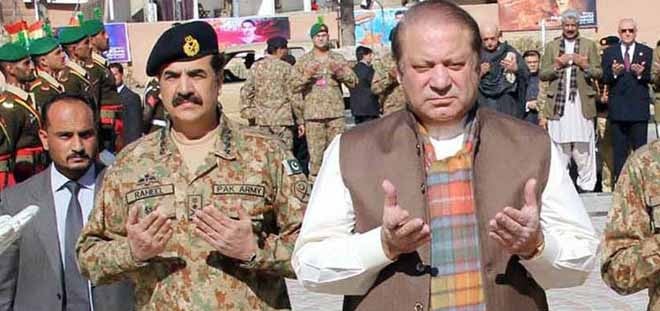

So, is this even okay to discuss the PML-N government’s role in the current crisis? Is this not a straight war between the military and media, two of the most unaccountable institutions, now locked in a volley of accusatory gunfire?
On the face of it, this is exactly what it looks like --a political government dragged unnecessarily into a conflict and now expected to quell the tensions. Caught between two institutions, it could not afford to annoy either. It hardly wasted a minute in ordering a judicial commission to investigate the attack as per the demands of the media/family and simultaneously put a seal of approval to ISI’s application to Pemra against the channel by getting it duly signed by the ministry of defence (whether it was signed by the minister himself is still a matter of conjecture).
Yet, it is the PML-N government that has to bear the brunt of the crisis that shows no signs of averting any time soon. And that requires a different and deeper understanding of the events. If you try to look at it this way, the Hamid Mir incident, in fact, came in the middle of an ongoing battle of nerves contained in the omnipresent civ-mil imbalance.
To its disadvantage, the PML-N carries the burden of a recent history which the military does not see in a very flattering light. It is almost impossible to disconnect the speech that Khawaja Asif made in the parliament as a mere member of the opposition in 2006 from the fact that he is now nothing less than the country’s minister of defence. No wonder this speech was immediately searched, dusted, and brought to the listening ears of the people of this country, in case they had missed it then.
The PML-N government carries another, even more recent, burden --the example of its predecessor that it is advised to follow. Each time the PPP government was pitched against the military’s power in its tenure -- and there were quite a few times -- it succumbed. At one time, in the Memo case, it almost came to the brink but the government looked towards the presidency whose survival instinct was strong enough to weather any storm. Against all expectations, the government completed its five years.
The PML-N was expected to have learnt its lesson, from its own tenures in the 1990s, from the 1999 coup and from the PPP’s example. This time, it was all set to turn the economy around and deliver where the PPP had failed. What was not a part of its calculations was the return of the nemesis, the former coup-maker, Pervez Musharraf into the country to do politics.
Now that is a huge anomaly in Pakistani politics as it would be in any other country of the world. Dictators do not have an exit strategy and this one was looking at one that allowed him to re-enter. The personal wounds were too fresh for the party members even if the ultimate punishment was not on their minds. The media, basking in the glory of its instrumental role in ousting the dictator, was too keen to get the views of some ministers on the possible trial of Gen. Musharraf. Confident of their recent electoral victory, the ministers did not hesitate to speak their minds.
To be fair to them, they made a clear distinction between the man and the institution. They thought this distinction was safe enough since the institution itself had maintained a distance from the man in 2007. But the government did initiate the trial, thinking it could leave the rest to the courts. This could be read as a hamartian moment for the PML-N government.
The haughty media ensured the historical anomaly was righted by the trial of a dictator who was still living and who made not one but two coups. The proceedings of the trial were discussed threadbare on the media day in and day out till the time came for the former president to come before the court.
In the full glare of cameras, the route was changed. When Musharraf ended up at the Armed Forces Institute of Cardiology (AIFC) instead of the court room, it was considered the end of the story. The connection between the man and the institution was reestablished. But the blatant manner in which Musharraf’s lawyers, especially Ahmed Raza Kasuri, came on the media and emphasised and reemphasised this connection must have annoyed the victims in PML-N and they insisted on the position they’d taken earlier.
It was to bring an end to this confrontational approach that the chief of army staff issued a statement through ISPR some days before the attack on Hamid Mir. The government took a defensive posture and the prime minister even went to address the Kakul military academy. The tension had only been temporarily averted when this incident happened.
So what is the PML-N doing now? The causes upheld by Hamid Mir -- civilian supremacy, Balochistan, missing persons, Musharraf trial -- are equally dear to PML-N. Caught in an unenvious position, it wants to act as a neutral arbiter rather than an active player.
For present, the military seems to have won this battle round. If there is one sign of its ascendancy (even if you ignore the huge protests of religious organisations in its favour and the manipulative social media attacks on those who criticise the forces), it is in how the cable operators are blackmailed into blocking the channels of one media house or shifting their sequence arbitrarily.
As for the government, it continues to raise a few odd voices like Rana Sanaullah warning the army against banned outfits protesting in its favour and Khawaja Saad Rafique saying that media freedom and difference of opinion cannot be called treason.
An earlier version of this article stated Khawaja Asif’s speech was aired after the attack on Hamid Mir. The error is regretted.